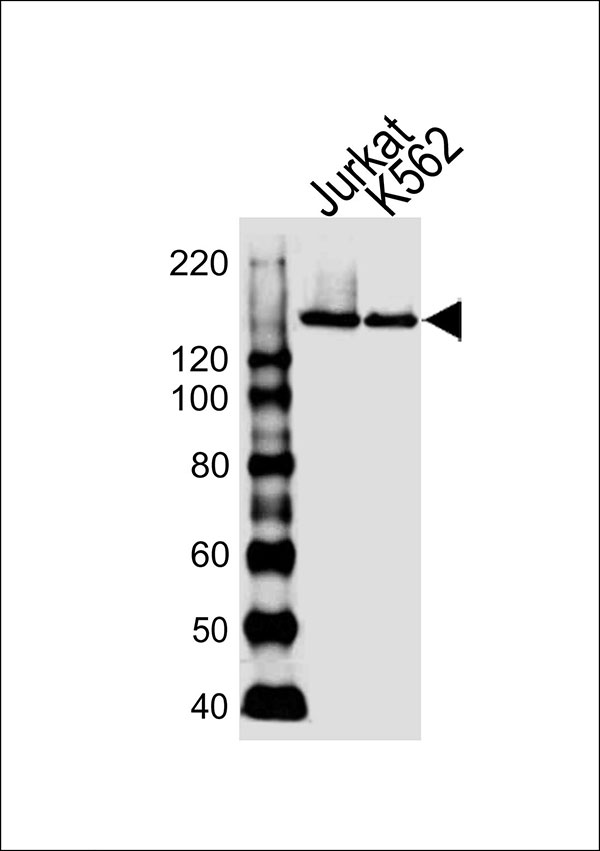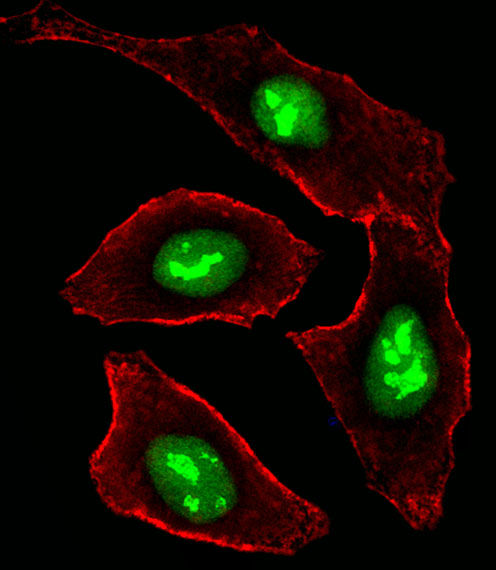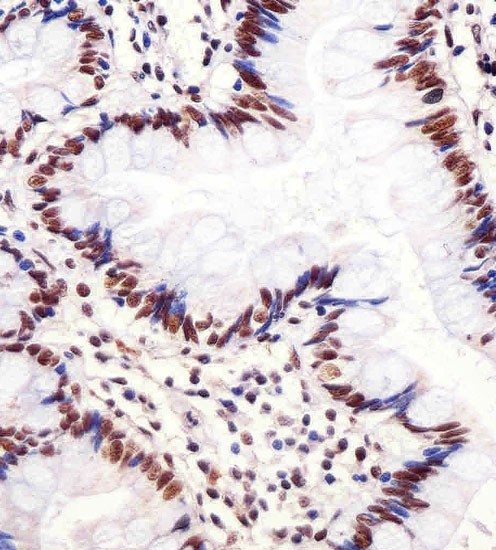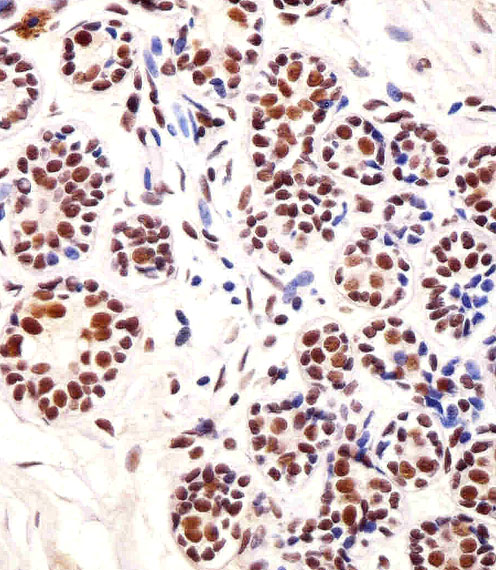DHX9 Antibody (N-term)
Affinity Purified Rabbit Polyclonal Antibody (Pab)
- 产品详情
- 文献引用 : 1
- 实验流程
- 背景知识
Application
| IHC-P, IF, WB |
|---|---|
| Primary Accession | Q08211 |
| Other Accession | Q28141 |
| Reactivity | Human |
| Predicted | Mouse, Rat, Bovine |
| Host | Rabbit |
| Clonality | Polyclonal |
| Calculated MW | 140958 Da |
| Isotype | Rabbit IgG |
| Antigen Source | Human |
| Gene ID | 1660 |
|---|---|
| Antigen Region | 1-30 aa |
| Other Names | ATP-dependent RNA helicase A;DDX9; LKP; NDH2; ATP-dependent RNA helicase A; ATP-dependent RNA helicase A; DEAH box protein 9; ATP-dependent RNA helicase A; Leukophysin; ATP-dependent RNA helicase A; Nuclear DNA helicase II |
| Dilution | IHC-P~~1:100~500 IF~~1:25 WB~~1:1000 |
| Target/Specificity | This DHX9 antibody is generated from rabbits immunized with a KLH conjugated synthetic peptide between 1-30 amino acids from the N-terminal region of human DHX9. |
| Format | Purified polyclonal antibody supplied in PBS with 0.09% (W/V) sodium azide. This antibody is purified through a protein A column, followed by peptide affinity purification. |
| Storage | Maintain refrigerated at 2-8°C for up to 2 weeks. For long term storage store at -20°C in small aliquots to prevent freeze-thaw cycles. |
| Precautions | DHX9 Antibody (N-term) is for research use only and not for use in diagnostic or therapeutic procedures. |
| Name | DHX9 (HGNC:2750) |
|---|---|
| Function | Multifunctional ATP-dependent nucleic acid helicase that unwinds DNA and RNA in a 3' to 5' direction and that plays important roles in many processes, such as DNA replication, transcriptional activation, post-transcriptional RNA regulation, mRNA translation and RNA-mediated gene silencing (PubMed:11416126, PubMed:12711669, PubMed:15355351, PubMed:16680162, PubMed:17531811, PubMed:20669935, PubMed:21561811, PubMed:24049074, PubMed:24990949, PubMed:25062910, PubMed:28221134, PubMed:9111062, PubMed:37467750). Requires a 3'- single-stranded tail as entry site for acid nuclei unwinding activities as well as the binding and hydrolyzing of any of the four ribo- or deoxyribo-nucleotide triphosphates (NTPs) (PubMed:1537828). Unwinds numerous nucleic acid substrates such as double-stranded (ds) DNA and RNA, DNA:RNA hybrids, DNA and RNA forks composed of either partially complementary DNA duplexes or DNA:RNA hybrids, respectively, and also DNA and RNA displacement loops (D- and R-loops), triplex-helical DNA (H-DNA) structure and DNA and RNA-based G-quadruplexes (PubMed:20669935, PubMed:21561811, PubMed:24049074). Binds dsDNA, single-stranded DNA (ssDNA), dsRNA, ssRNA and poly(A)-containing RNA (PubMed:10198287, PubMed:9111062). Also binds to circular dsDNA or dsRNA of either linear and/or circular forms and stimulates the relaxation of supercoiled DNAs catalyzed by topoisomerase TOP2A (PubMed:12711669). Plays a role in DNA replication at origins of replication and cell cycle progression (PubMed:24990949). Plays a role as a transcriptional coactivator acting as a bridging factor between polymerase II holoenzyme and transcription factors or cofactors, such as BRCA1, CREBBP, RELA and SMN1 (PubMed:11038348, PubMed:11149922, PubMed:11416126, PubMed:15355351, PubMed:28221134, PubMed:9323138, PubMed:9662397). Binds to the CDKN2A promoter (PubMed:11038348). Plays several roles in post-transcriptional regulation of gene expression (PubMed:28221134, PubMed:28355180). In cooperation with NUP98, promotes pre-mRNA alternative splicing activities of a subset of genes (PubMed:11402034, PubMed:16680162, PubMed:28221134, PubMed:28355180). As component of a large PER complex, is involved in the negative regulation of 3' transcriptional termination of circadian target genes such as PER1 and NR1D1 and the control of the circadian rhythms (By similarity). Also acts as a nuclear resolvase that is able to bind and neutralize harmful massive secondary double-stranded RNA structures formed by inverted-repeat Alu retrotransposon elements that are inserted and transcribed as parts of genes during the process of gene transposition (PubMed:28355180). Involved in the positive regulation of nuclear export of constitutive transport element (CTE)-containing unspliced mRNA (PubMed:10924507, PubMed:11402034, PubMed:9162007). Component of the coding region determinant (CRD)-mediated complex that promotes cytoplasmic MYC mRNA stability (PubMed:19029303). Plays a role in mRNA translation (PubMed:28355180). Positively regulates translation of selected mRNAs through its binding to post-transcriptional control element (PCE) in the 5'-untranslated region (UTR) (PubMed:16680162). Involved with LARP6 in the translation stimulation of type I collagen mRNAs for CO1A1 and CO1A2 through binding of a specific stem-loop structure in their 5'-UTRs (PubMed:22190748). Stimulates LIN28A- dependent mRNA translation probably by facilitating ribonucleoprotein remodeling during the process of translation (PubMed:21247876). Plays also a role as a small interfering (siRNA)-loading factor involved in the RNA-induced silencing complex (RISC) loading complex (RLC) assembly, and hence functions in the RISC-mediated gene silencing process (PubMed:17531811). Binds preferentially to short double- stranded RNA, such as those produced during rotavirus intestinal infection (PubMed:28636595). This interaction may mediate NLRP9 inflammasome activation and trigger inflammatory response, including IL18 release and pyroptosis (PubMed:28636595). Finally, mediates the attachment of heterogeneous nuclear ribonucleoproteins (hnRNPs) to actin filaments in the nucleus (PubMed:11687588). |
| Cellular Location | Nucleus. Nucleus, nucleoplasm. Nucleus, nucleolus. Cytoplasm. Cytoplasm, cytoskeleton, microtubule organizing center, centrosome. Note=Nucleoplasmic shuttling protein (PubMed:10198287, PubMed:10207077, PubMed:16375861, PubMed:9162007) Its nuclear import involves the nucleocytoplasmic transport receptor Importin alpha/Importin beta receptor pathway in a Ran-dependent manner (PubMed:16375861). In interphase, localizes in nuclear stress granules and at perichromatin fibrils and in cytoplasmic ribonucleoprotein granules (PubMed:10198287). Colocalizes with WRN and H2AX at centrosomes in a microtubule-dependent manner following DNA damaging agent treatment (PubMed:17498979). Excluded from the mitotic nucleus as early as prophase and re-entered the nucleus at telophase (PubMed:10198287). Recruited in diffuse and discrete intranuclear foci (GLFG-body) in a NUP98-dependent manner (PubMed:28221134). Colocalizes with SP7 in the nucleus (PubMed:17303075). Colocalizes with ACTB at nuclear actin filaments inside the nucleus or at the nuclear pore (PubMed:11687588). Colocalizes with HNRNPC at nuclear ribonucleoprotein complex proteins in the nucleus (PubMed:11687588). Localized in cytoplasmic mRNP granules containing untranslated mRNAs (PubMed:17289661). |
For Research Use Only. Not For Use In Diagnostic Procedures.

Provided below are standard protocols that you may find useful for product applications.
BACKGROUND
Unwinds double-stranded DNA and RNA in a 3' to 5' direction. Alteration of secondary structure may subsequently influence interactions with proteins or other nucleic acids. Functions as a transcriptional activator. Component of the CRD-mediated complex that promotes MYC mRNA stability. Involved with LARP6 in the stabilization of type I collagen mRNAs for CO1A1 and CO1A2.
REFERENCES
Lee C.-G., et al. J. Biol. Chem. 268:16822-16830(1993).
Abdelhaleem M.M., et al. J. Immunol. 156:2026-2035(1996).
Zhang S., et al. J. Biol. Chem. 272:11487-11494(1997).
Goshima N., et al. Nat. Methods 5:1011-1017(2008).
Gregory S.G., et al. Nature 441:315-321(2006).
终于等到您。ABCEPTA(百远生物)抗体产品。
点击下方“我要评价 ”按钮提交您的反馈信息,您的反馈和评价是我们最宝贵的财富之一,
我们将在1-3个工作日内处理您的反馈信息。
如有疑问,联系:0512-88856768 tech-china@abcepta.com.






















 癌症的基本特征包括细胞增殖、血管生成、迁移、凋亡逃避机制和细胞永生等。找到癌症发生过程中这些通路的关键标记物和对应的抗体用于检测至关重要。
癌症的基本特征包括细胞增殖、血管生成、迁移、凋亡逃避机制和细胞永生等。找到癌症发生过程中这些通路的关键标记物和对应的抗体用于检测至关重要。 为您推荐一个泛素化位点预测神器——泛素化分析工具,可以为您的蛋白的泛素化位点作出预测和评分。
为您推荐一个泛素化位点预测神器——泛素化分析工具,可以为您的蛋白的泛素化位点作出预测和评分。 细胞自噬受体图形绘图工具为你的蛋白的细胞受体结合位点作出预测和评分,识别结合到自噬通路中的蛋白是非常重要的,便于让我们理解自噬在正常生理、病理过程中的作用,如发育、细胞分化、神经退化性疾病、压力条件下、感染和癌症。
细胞自噬受体图形绘图工具为你的蛋白的细胞受体结合位点作出预测和评分,识别结合到自噬通路中的蛋白是非常重要的,便于让我们理解自噬在正常生理、病理过程中的作用,如发育、细胞分化、神经退化性疾病、压力条件下、感染和癌症。









